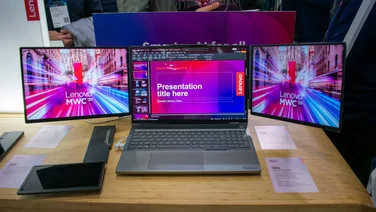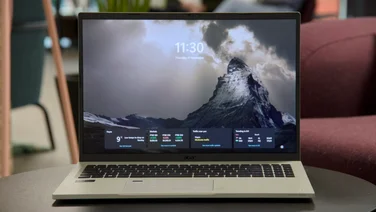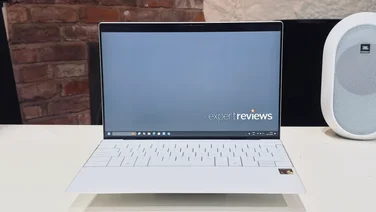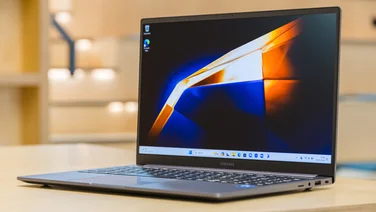To help us provide you with free impartial advice, we may earn a commission if you buy through links on our site. Learn more




















- Super-bright 16:10 screen
- Excellent keyboard and touchpad
- Strong performance
- No legacy connectors
- Heavier than you’d expect
- Mediocre pixel density on Full HD+ models
The Dell XPS 13 has long been one of our favourite laptops and the 2-in-1 laptop version takes that winning formula and adds a fold-around screen, giving you the option of working in tablet, stand or tent modes as well as the regular clamshell format.
The design isnt just flexible: its stylish too, not to mention very capable, and its not much more expensive than the non-convertible version. So, if youre in the market for a high-end laptop, the XPS 13 2-in-1 is well worth a look.
READ NEXT: Apple MacBook Pro 16in (2019) review
Dell XPS 13 2-in-1 (2019) review: What you need to know
The 2019 update of the XPS 13 2-in-1 looks very similar to last years iteration but it introduces a few key upgrades. For one, Dell has made the move from eighth-generation to tenth-generation Intel processors, so you get the power and performance benefits of the latest 10nm fabrication process.




















The webcam has also at last been moved to the top of the display bezel, as on the standard XPS 13, rather than pointing up from beneath the screen. And the screen itself has changed shape, going from a letterboxed 16:9 ratio to a slightly squarer 16:10 format. Wireless networking, meanwhile, has been upgraded to the latest 802.11ax standard (also known as Wi-Fi 6).
These may not be revolutionary changes but theyre all definite plus points, making this not just the best XPS 13 2-in-1 yet, but one of the best convertible laptops on the market.
Dell XPS 13 2-in-1 (2019) review: Price and competition
The Dell XPS 13 2-in-1 is offered in four configurations. The cheapest comes with an Intel Core i5-1035G1 CPU and a 1,920 x 1,200 touchscreen for £1,429. That may seem steep for an entry-level model but it includes 8GB of RAM and a 256GB SSD. To its credit, Dell doesnt muck about with smaller storage configurations.
The next model up is the one we tested, which is identical save for a Core i7-1065G7 CPU. The list price for this is £1,519 but, right now, its on offer at £1,399, making it cheaper than the Core i5 version.
The top two configurations use the same Core i7 processor but partner it with a 4K+ screen, which quadruples the standard resolution to 3,840 x 2,400 and have either 16GB of RAM with a 512GB SSD or 32GB of RAM with 1TB of storage. Officially, these high-end models cost £1,919 and £2,319 respectively, but Dells current promotional pricing brings them down to £1,749 and £2,099 decent savings, if youre shopping for a laptop of this type.




















Other options? Well, one obvious alternative is Microsofts flagship convertible, the Surface Pro 7: its a different take on the two-in-one concept, with a keyboard cover that snaps on and off rather than a fold-around screen but it does a similar job. The Core i7 model with 16GB of RAM and 512GB of storage will set you back £1,605 not including the keyboard but there are plenty of other specifications to choose from at Microsofts online store.
Alternatively, theres the Lenovo ThinkPad X1 Yoga. Coming from the company that invented the 360° hinge this looks and feels as classy as youd hope and is available in various configurations costing £1,449 and up. There’s also the Lenovo Yoga C940, which is also a fine convertible laptop with prices starting at £1,100. The HP Spectre x360 is another contender with the same hinged design, now featuring 10th-generation Intel CPUs and 4K screens for £1,799 from the HP online store.
If youre not attached to the laptop-cum-tablet concept, wed also suggest you consider the standard non-convertible Dell XPS 13 priced from £1,199 with a non-touch screen and a Core i5 processor, or £1,299 with a Core i7 or Microsofts latest Surface Laptop, whose 256GB models start at a tempting £1,139.
READ NEXT: Surface Pro 7 review
Dell XPS 13 2-in-1 (2019) review: Design
As with all Dells XPS 13 systems, the 2-in-1 features an eye-catching InfinityEdge display, which in laymans terms means it has really thin bezels. It looks great, its fully touch-enabled and it lets the manufacturer squeeze a 13.4in screen into a relatively small chassis, measuring 296 x 207 x 13mm at the rear and tapering to a thickness of just 7mm at the front. Its a wonderfully portable package, although at 1.33kg its a little weightier than most traditional laptops.
The defining feature of the 2-in-1 is its wraparound hinge but, in truth, theres not a lot to say about this. It feels suitably firm but not overly stiff and, when you fold it back beyond around 185°, the keyboard and touchpad are automatically disabled and a little notification pops up inviting you to switch Windows into tablet mode. Pivot it back into standard laptop position and your input devices become active once again. Its simple and fuss-free and thats a good thing.
On the subject of the keyboard, however, this doesnt physically recede or lock, so as with many other convertibles holding the 2-in-1 in tablet mode, with the keys at the rear, feels a little odd. Its not too jarring, however, as the keys are low profile with minimal travel distance. They still feel beautifully crisp and positive to type on, though.




















Indeed, Id go so far as to say its one of the best-feeling laptop keyboards Ive ever tried and the layout is agreeably spacious, too. The only real problem is the half-height Page Up and Down keys, which are situated hard up against the left and right cursor keys. Its annoyingly easy to hit these by accident and make your cursor instantly leap off to some unexpected place but your fingers will get used to it after a few days.
I cant fault the touchpad, either. While not quite as huge as the pad on the Microsoft Surface Laptop 3, its 112 x 67mm dimensions feel perfectly roomy and finger-tracking is impeccably smooth and precise. Its hinged at the top, so physical clicks register better in its lower half but I found taps and swipes were picked up perfectly all across its surface.
An aspect of the Dell XPS 13 2-in-1 that might be more controversial is its physical connectivity or rather its lack thereof. As with last years edition, the 2019 2-in-1 completely eschews old-style USB connectors, offering a pair of Type-C sockets (one at each side) for connecting peripherals and charging.




















To be fair, these are both USB 3.1 connectors with support for Thunderbolt 3, so theyre as fast and versatile as you could ask for but if you want to hook up any legacy devices youll need an adaptor. The only other sockets on offer are a microSD card slot and a headphone jack.
Another slight compromise is the webcam. Its impressive that Dell has managed to cram a 720p sensor into the tiny upper bezel above the screen but, in use, I found the image soft and noisy: its fine for chatting with friends, but if you dream of YouTube stardom youll want something better.
Similarly, the speakers are perfectly clear, but a touch on the tinny side, and not exactly loud. Id be more than happy to use the XPS 13 2-in-1 to watch iPlayer in bed, but I wouldnt choose it to provide background music at a dinner party. Still, the built-in microphone is surprisingly clean and warm.




















Finally, I have to mention that, while the plain black touchpad and subtly patterned wrist-rests look stylish and feel pleasingly warm to the touch, I found they quickly became visibly smudged with finger and palm-prints. This doesnt affect the functioning of the laptop in any way but if you want to show off your shiny new convertible, be prepared to give it a regular wipe-down.
Dell XPS 13 2-in-1 (2019) review: Display
Ive never been a fan of widescreen displays on laptops: I much prefer the taller 3:2 format of Microsofts Surface devices and the Huawei Matebook X Pro. Dells new 1,920 x 1,200 panel is a bit more rectangular than that but its a definite improvement over the Full HD displays used on previous XPS versions.
Its a superb screen, too. We measured an amazing maximum brightness of 538cd/m2, outshining even Apples newest 16in MacBook Pro (which topped out at 471cd/m2). A contrast ratio of 1,761:1, meanwhile ensures that the picture looks fantastically solid and vibrant, with the sort of dynamic range that only an OLED panel could hope to beat.




















Even more impressive is the screens colour performance. In our colorimeter test, the XPS 13 2-in-1 delivered a very creditable 97.1% coverage of the sRGB colour space, with an excellent average Delta E of 1.18. Thats not quite perfect, but its near enough to satisfy most professionals working in the visual arts. Theres support for HDR video streaming too, although not for wide-gamut apps or games.
Ive only one reservation about the XPS 13 2-in-1s screen, and thats to do with sharpness. The expensive 4K+ variants boast an ultra-high pixel density of 338ppi, but on the Full HD+ models thats slashed to 169ppi. Thats quite a bit coarser than the 227ppi of the Apple MacBook Pro, or the 267ppi of the Microsoft Surface Pro 7 and it shows. Text, in particular, looks slightly soft-edged and grainy, rather than perfectly sharp and smooth. It doesnt ruin the visual experience but its disappointing at this price.
READ NEXT: Surface laptop 3 review
Dell XPS 13 2-in-1 (2019) review: Performance
The XPS 13 2-in-1 uses Intels latest top-of-the-range mobile Core i7 processor, the i7-1065G7 so despite its slimline design, we expected strong performance. And in our standard 4K media benchmarks, thats exactly what we got, with scores that held up very well relative to the Core i7 versions of its main rivals:

Its particularly impressive how far the Dell XPS 13 2-in-1 pulls ahead of competing convertibles. In the case of the Lenovo, that probably has something to do with the older eighth-generation CPU; the Surface Pro 7, meanwhile, uses the same processor as the XPS 13 2-in-1, but its one-piece design limits its cooling capabilities, meaning the CPU can only hit its top speed of 3.9GHz for short bursts. Weve previously observed heat-related performance issues with the HP Spectre x360, too, although its not included in this comparison as we havent yet had an opportunity to put the latest model to the test.
Indeed, with an overall benchmark score of 99 the Dell XPS 13 2-in-1 happily keeps up with the Core i7-powered version of the regular XPS 13, and the corresponding model of the Microsoft Surface Laptop 3. The third-party Geekbench 4 benchmark tells much the same story:

Its worth mentioning that our XPS 13 2-in-1 test model came fitted with 16GB of RAM, rather than the 8GB thats standard for this configuration. These desktop benchmarks arent particularly memory-intensive, however, so you can expect to see very similar results from the regular 8GB model.
As for graphical performance, the Core i5 version of the XPS 13 2-in-1 comes with bog-standard integrated graphics but the Core i7 silicon includes a more powerful Iris Plus-branded GPU. This doesnt mean you can run the latest 3D games with all the detail settings whacked up to maximum: unsurprisingly, the Full HD, high-detail Hitman 2 benchmark proved beyond the 2-in-1s capabilities, giving us a jerky average frame rate of 16fps. Even so, the GFXBench test suite confirms that theres at least as much graphical power here as on any comparable laptop:

In practice, this meant we were able to enjoy Dirt Showdown at 720p with high detail settings at a beautifully smooth 57fps, and even in Metro: Last Light Redux the XPS 13 2-in-1 kept up a playable average frame rate of 32fps at 1080p.
Battery life is another strength. In our video rundown test, with the display set to a standard brightness of 170cd/m2, the XPS 13 2-in-1 lasted a very creditable 9hrs 8mins, easily outlasting both its 2-in-1 competitors and the Surface Laptop 3. The common or garden XPS 13 fared even better, with an outstanding score of 10hrs 35mins but, even so, the convertible version remains a strong performer.

One area where the XPS 13 2-in-1 isnt quite so impressive is storage performance. Although Dell uses NVMe SSD storage, the 512GB Toshiba unit in our review model delivered merely average read and write speeds for a drive of this type:
For most tasks this wont be a problem at all, but it does mean that when saving large files, you dont quite get the same sort of snappiness as on the Lenovo ThinkPad X1 Yoga.
As a final plus point, the new XPS 13 2-in-1 supports 802.11ax, allowing you to take advantage of the very fastest Wi-Fi speeds (just as soon as you buy a compatible router). Thats good to see, although its not much of a distinction: with the exception of the Lenovo X1 Yoga, the other convertible and laptop systems weve been comparing have all also moved up to the new standard.
Dell XPS 13 2-in-1 (2019) review: Verdict
Inevitably, every convertible design has its trade-offs but, for my money, the XPS 13 2-in-1 is the most attractive take Ive seen on the idea. Dell has created a superb, uncompromising laptop, which just happens to also offer the convenient option of flipping around into tent or tablet mode.
Of course, if you genuinely have no use for the folding design then you can save money by choosing a regular Dell XPS 13 or a Surface Laptop with a taller, sharper screen. Conversely, if you plan to use tablet mode on a regular basis, you might find the Surface Pro 7 suits you better: its thinner and lighter, and doesnt have a keyboard sticking awkwardly out of the back.
For many everyday laptop users, however, I suspect the idea of a high-quality touchscreen system that can occasionally be transformed into other modes will hit the sweet spot perfectly. Even if youd ordinarily turn your nose up at a convertible design, therefore, you may well find it hard to resist the charms of this fast, stylish, powerful and portable two-in-one.






